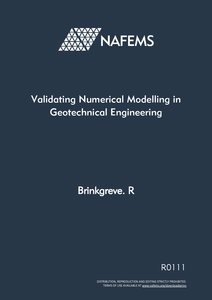
In recent decades, the Finite Element Method has been used increasingly for the analysis of stress, deformation, structural forces, bearing capacity, stability and groundwater flow in geotechnical engineering applications. Besides developments related to the method itself (e.g. new constitutive models for soil and rock, new numerical procedures and calculation methods), the role of the FEM has evolved from a research tool into a daily engineering tool. This has been possible because of the increase of computer power, available for every engineer, and the development of robust and user-friendly software packages. The finite element method has obtained a place alongside conventional design methods, and offers significant advantages in complex situations, such as the design of tunnels and deep excavations in urban areas. However, as with every other method, the FEM also has its limitations. These limitations are not always recognised by users of finite element software, which can lead to unreliable designs.
Despite the development of easy-to-use finite element programs, it is difficult to create a good model that enables a realistic analysis of the physical processes involved in a real project and that provides a realistic prediction of design quantities (i.e. displacements, stresses, pore pressures, structural forces, bearing capacity, safety factor, drainage capacity, pumping capacity, etc.). This is particularly true for geotechnical applications, because the highly non-linear and heterogeneous character of the soil material is difficult to capture in numerical models. The complexity of soil behaviour is caused by various phenomena on the soil particle level and leads to macroscopic observations such as stress-, stress path and strain dependency of stiffness, critical state behaviour and failure, compaction and dilatancy, strain localisation, creep, relaxation, anisotropy, variability of properties, and several more. When using the finite element method, soil is modelled by means of a constitutive model (stress-strain relationship) which is formulated in a continuum framework. The choice of the constitutive model and the corresponding set of model parameters are the most important issues to consider when creating a finite element model for a geotechnical project. It forms the main limitation in the numerical modelling process, since the model (no matter how complex) will always be a simplification of the real soil behaviour. The previous publication from the NAFEMS Geotechnical Committee (Lees, 2012) describes the process of soil model selection and parameter determination in detail. In the current document we will focus on the process of validating the numerical model.
Considering the use of geotechnical finite element software, it is often the younger generation of engineers who perform the numerical modelling and produce colourful results; sometimes without fully understanding the backgrounds and limitations of the constitutive models and the numerical methods used in the software. Supervisors, i.e. project managers or senior engineers, often find it difficult to validate the outcome, especially when these do not match with what they would expect based on their experience. This leads to the conclusion that there is a need for guidelines on validation of geotechnical finite element calculations, which is the primary motivation for this document.
Aim and Scope
This book is intended to provide guidelines on validation and verification procedures for finite element models for geotechnical engineering purposes. Therefore, it first provides insight into the discrepancies between a real project and the corresponding numerical model, in order to indicate the key subjects of the validation process. Then it provides guidelines on methods that can be applied to validate the numerical models. In addition to the ‘technical’ issues, the book also includes a chapter on non-technical issues related to the validation process, such as responsibilities of the various persons and entities involved.
Intended Readership
The book is intended for different categories of readers:
Users of finite element software, who are often young engineers, are challenged to think carefully about the modelling choices that they make, the limitations of the methods that they are using, and how to validate their choices as well as the results obtained from their numerical model.
Supervisors, who sometimes have limited experience with numerical models, will gain insight into the critical modelling issues and will be able to ask the right questions to the modellers in order to get a sense of the quality of the results.
Developers of finite element software will recognise their responsibilities in developing validated software for geotechnical engineering and design. Based on the information provided herein, they may implement tools to enhance the validation process by the user.



